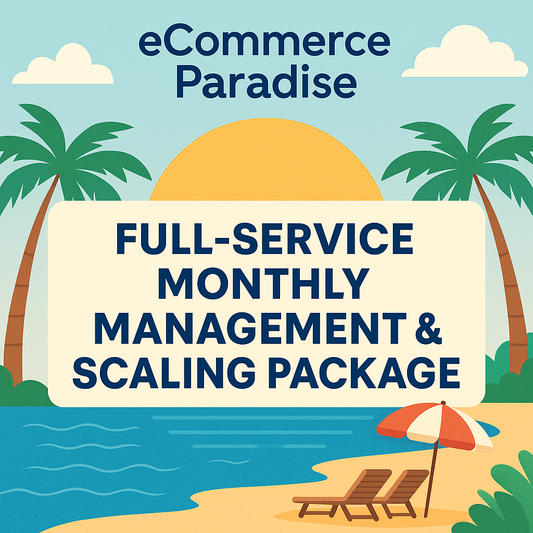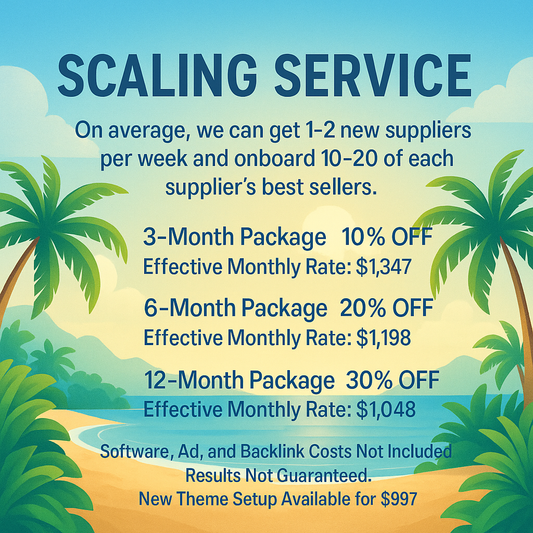How to Do Keyword Research for Your Shopify Store (The Smart Way)
Master the first and most important step in ecommerce SEO.
If you're running a Shopify store and want to get more traffic without constantly paying for ads, SEO is the answer.
But the truth is — SEO doesn’t work without keyword research.
Most ecommerce entrepreneurs skip this step or just guess what people are searching for. That's a recipe for disappointment.
In this guide, I’ll show you how to do keyword research the right way — so your store ranks higher, attracts the right visitors, and converts them into buyers.
💡 Why Keyword Research Is the Foundation of Ecommerce SEO
Think of keyword research as market research for your content and pages.
If you know exactly what your customers are searching for — and you create pages that match those search terms — you’ll show up in the right results, at the right time, for the right people.
SEO traffic is free, scalable, and consistent. But only if you target the right keywords — specifically, the ones that signal purchase intent.
✨ Not All Keywords Are Equal
-
“Skateboarding” is broad. People could be looking for tricks, events, or history.
-
“Best complete skateboard for beginners” shows someone who’s ready to buy.
That’s the difference between a browser and a buyer.
🔍 Step 1: Understand Buyer-Intent Keywords
Buyer-intent keywords are the ones that bring in the money.
These are phrases people type into Google when they’re actively shopping, like:
-
“buy off-grid solar system kit”
-
“best mobility scooter for travel”
-
“top-rated outdoor pizza oven”
-
“compact refrigerator for tiny house”
-
“wooden ramps for backyard skatepark”
These keywords are usually:
-
More specific (long-tail)
-
Lower competition
-
Easier to rank for
-
Closer to the sale
You want to find dozens (or hundreds) of these for your products, collections, and blog content.
🔧 Step 2: Use Tools to Find Keyword Data
Start by entering your product names, collections, or ideas into these keyword tools:
🔹 Ubersuggest
Great for beginners. Shows volume, difficulty, and related keyword ideas.
🔹 Google Keyword Planner
Free but requires a Google Ads account. Gives exact volume and CPC data.
🔹 Ahrefs (Paid)
Powerful tool for keyword research and competitor analysis.
🔹 Keywords Everywhere (Chrome Extension)
Shows keyword data directly in Google search results and YouTube.
When evaluating keywords, look for:
-
Search volume: Aim for 100–1000/month when starting
-
Keyword difficulty (KD): Under 30 is good if your site is new
-
CPC (cost per click): Higher = more valuable (buyers are searching)
🕵️♂️ Step 3: Spy on Your Competitors
Want to shortcut the process? Look at what’s already working.
Here’s how:
-
Plug your competitors’ URLs into Ubersuggest or Ahrefs
-
Check their top-performing pages and keywords
-
Find what keywords are driving traffic
-
Look for opportunities to create better, more optimized versions
You might find that a competitor is ranking for “portable pizza oven for camping” — and realize you can create a collection or blog post around the same term.
🗂️ Step 4: Build a Keyword Map for Your Store
A keyword map is a simple spreadsheet that assigns target keywords to each key page on your site. It helps you avoid overlap and makes sure every page has a clear purpose.
Example structure:
| Page Type | URL | Target Keyword |
|---|---|---|
| Homepage | / | solar kits for homes |
| Collection Page | /complete-solar-kits | complete solar system kits |
| Product Page | /products/bluetti-3000w-kit | bluetti 3000w solar generator kit |
| Blog Post | /blog/best-pizza-ovens-for-camping | best pizza ovens for camping |
Use this keyword map to guide how you write titles, meta descriptions, H1s, and content.
✅ Keyword Research Checklist
Before you move on, check these off:
-
Identified long-tail, buyer-intent keywords
-
Used at least one keyword research tool
-
Checked monthly volume and competition
-
Spied on at least one competitor’s keyword strategy
-
Created a keyword map for homepage, collections, products, and blogs
💬 Advanced Tips & Common Mistakes
🔥 Pro Tips:
-
Use your store’s internal search data (if available) to find real search terms
-
Include branded keywords if people are searching for your brand
-
Don’t forget local intent keywords if you have a physical presence
🚫 Avoid These Mistakes:
-
Don’t only go after high-volume keywords (they’re often too competitive)
-
Don’t guess — let the data guide you
-
Don’t try to rank one page for too many keywords at once
📥 Want Help With Keyword Research?
I’ve helped dozens of ecommerce store owners discover the right keywords and structure their stores for SEO success. If you want to shortcut the process:
Next in the series:
➡️ How to Structure Your Shopify Store for SEO (and Avoid Common Mistakes)


















